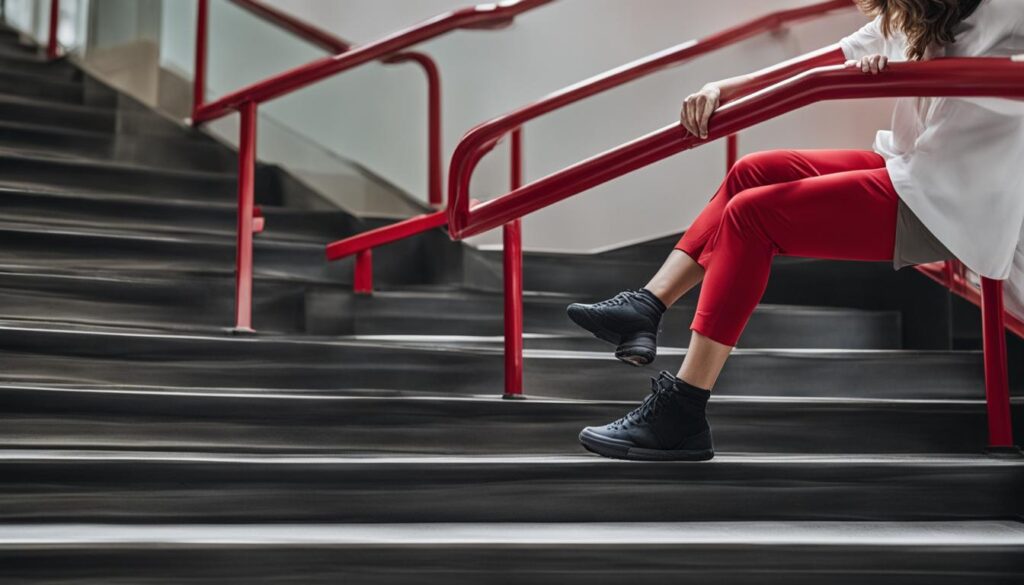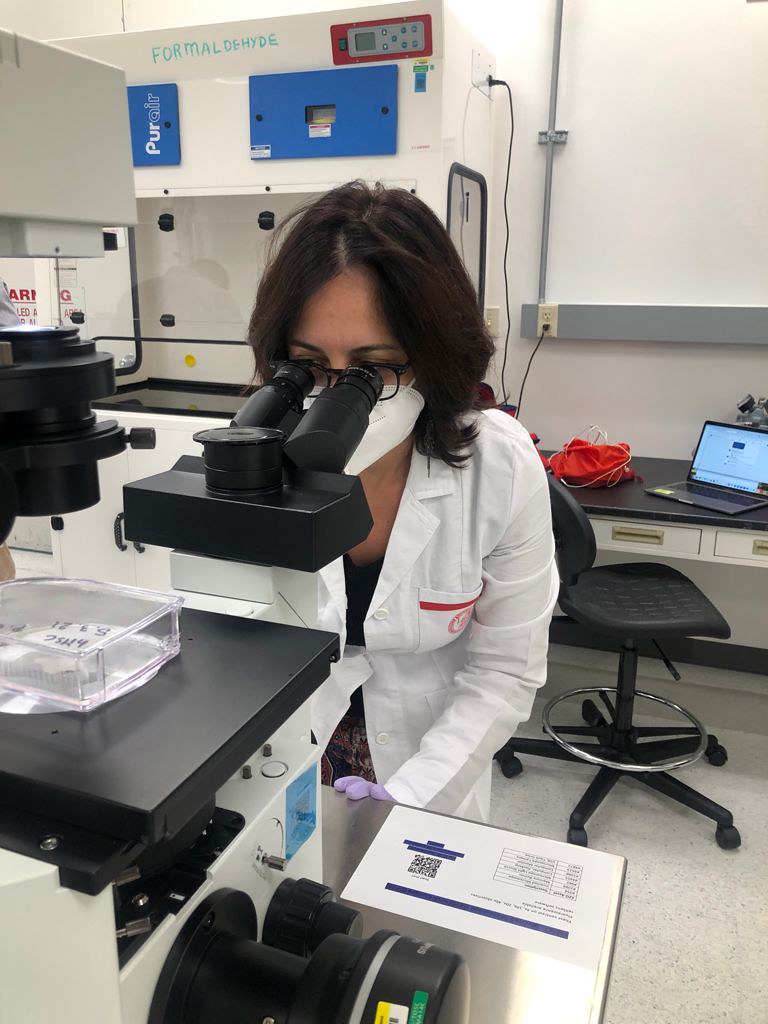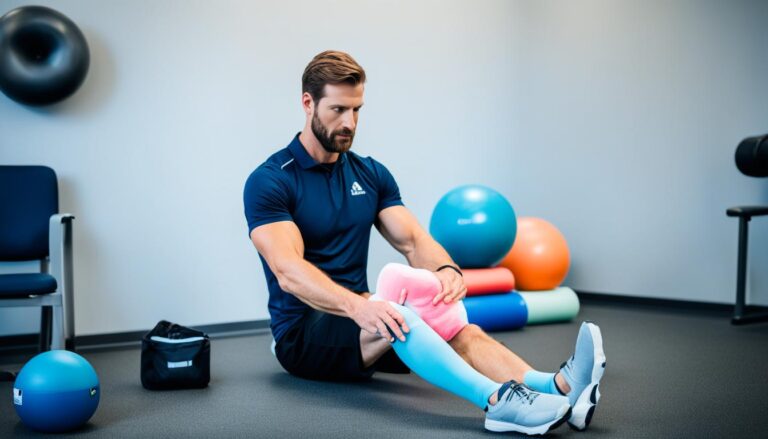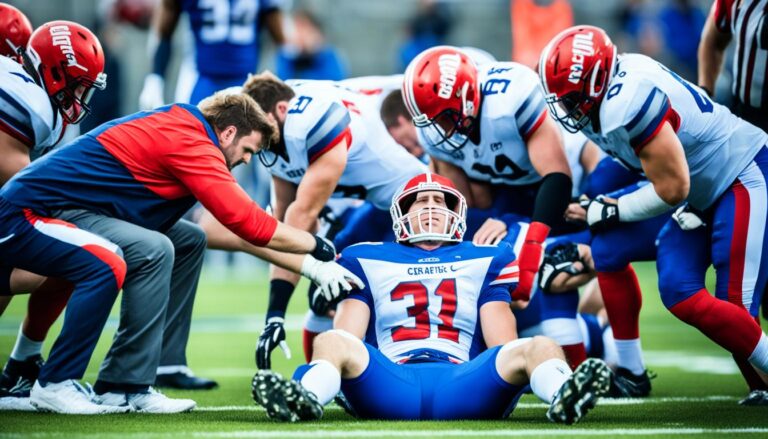Ease Knee Pain from Stairs Climbing
If you’ve ever experienced knee pain when climbing stairs, you know how frustrating and uncomfortable it can be. The simple act of ascending a flight of stairs can turn into a challenging task, causing knee discomfort and hindering your mobility. But fear not, there are strategies you can employ to alleviate and manage knee pain when climbing stairs, allowing you to continue with your daily activities without the constant agony.
Key Takeaways
- Understanding the causes of knee pain on stairs is crucial to implementing the right treatment and management strategies.
- Strengthening and stretching exercises can help improve knee strength and alleviate pain when climbing stairs.
- Body awareness and modification techniques, such as modifying walking techniques, can provide significant relief from knee pain on stairs.
- Exploring knee-friendly alternatives to stairs, such as elevators or ramps, can help reduce knee discomfort.
- Incorporating regular movement, wearing supportive shoes, and using handrails for support are all essential tips for alleviating knee pain on stairs.
Understanding Knee Pain on Stairs
Knee pain when climbing stairs can be a common and frustrating problem for many individuals. The act of stair climbing places additional stress on the knee joint, which can lead to discomfort and pain. There are several factors that can contribute to knee pain on stairs, including:
- Patellofemoral pain syndrome
- Meniscus tears
- Chondromalacia patella
- IT band syndrome
- Muscle imbalance
These conditions can cause inflammation, instability, or damage to the structures of the knee, making it more susceptible to pain while ascending stairs.
Understanding the specific condition causing your knee pain is crucial in implementing the appropriate treatment and management strategies. Consulting with a healthcare professional or orthopedic specialist can help in diagnosing the underlying cause of your knee pain and determining the most effective course of action.

Causes of Knee Pain on Stairs
Let’s take a closer look at some of the common causes of knee pain on stairs:
| Cause | Description |
|---|---|
| Patellofemoral pain syndrome | A condition characterized by pain in the front of the knee, often aggravated by activities such as stair climbing. It is caused by excessive pressure on the patellofemoral joint. |
| Meniscus tears | Tears in the meniscus, the cartilage that cushions the knee joint. These tears can cause pain, swelling, and limited range of motion. |
| Chondromalacia patella | Also known as runner’s knee, it is a condition characterized by softening and damage to the cartilage on the underside of the kneecap. |
| IT band syndrome | A condition where the iliotibial (IT) band becomes tight or inflamed, causing pain on the outside of the knee. |
| Muscle imbalance | Weak or imbalanced muscles around the knee can contribute to poor knee alignment and increased stress on the joint during stair climbing. |
By identifying the specific cause of your knee pain on stairs, you can work towards implementing targeted treatment and management strategies to alleviate discomfort and improve your ability to navigate stairs with ease.
Strengthening and Stretching Exercises
Strengthening and stretching exercises can play a crucial role in relieving knee pain on stairs and improving overall knee health. By targeting the structures surrounding the knee joint, these exercises provide support, stability, and increased flexibility, which are essential for pain relief and enhanced mobility. Incorporating specific exercises into your routine can help alleviate knee pain and strengthen the muscles that support the knee. Here are some key exercises to consider:
1. Hip Flexor Stretches
Hip flexor stretches can help alleviate knee pain by improving flexibility in the hip and reducing tension on the knee joint. To perform this stretch, start by kneeling on one knee with the other foot planted firmly on the ground in front of you. Gently lunge forward, keeping your back straight and feeling a stretch in the front of your hip. Hold the stretch for 30 seconds and repeat on the other side. This exercise can be done multiple times a day to help reduce knee discomfort.
2. Single-Leg Lifts
Single-leg lifts are an effective exercise for strengthening the muscles around the knee joint, including the quadriceps and hamstrings. To perform this exercise, stand behind a sturdy chair or using a wall for support. Lift one leg off the ground, extending it straight in front of you, and hold for a few seconds. Slowly lower the leg and repeat with the other leg. Aim for 10-15 repetitions on each leg, gradually increasing the number of repetitions as you build strength.
3. Hamstring Stretches
Tight hamstrings can contribute to knee pain on stairs, so incorporating hamstring stretches into your routine can help alleviate discomfort. To perform this stretch, sit on the edge of a chair or a step with one leg extended straight in front of you. Keep your back straight and hinge forward at the hips, feeling a gentle stretch in the back of your thigh. Hold the stretch for 30 seconds and repeat on the other side. Aim to perform this stretch daily to improve flexibility in your hamstrings and reduce knee pain.
4. Other Exercises
In addition to hip flexor stretches, single-leg lifts, and hamstring stretches, there are several other exercises that can help alleviate knee pain on stairs and strengthen the supporting muscles. These exercises include squats, lunges, calf raises, and wall sits. It is important to select exercises that do not provoke pain and focus on strengthening the glutes, hamstrings, and quadriceps. Working with a physical therapist or a qualified fitness professional can provide personalized guidance and tailored exercises to address your specific needs.
Incorporating these strengthening and stretching exercises into your routine can help alleviate knee pain on stairs and promote better knee health overall. It is important to listen to your body and consult with a healthcare professional if you experience ongoing or severe knee pain. Remember to start slowly and gradually increase the intensity and duration of your exercises to avoid further strain or injury to your knees. By incorporating these exercises, you can improve knee strength, reduce pain, and make stair climbing a more comfortable and manageable activity.
| Exercise | Benefits |
|---|---|
| Hip Flexor Stretches | Improves flexibility in the hip, reduces tension on the knee joint |
| Single-Leg Lifts | Strengthens quadriceps and hamstrings |
| Hamstring Stretches | Improves flexibility in the hamstrings, reduces knee discomfort |
| Other Exercises (squats, lunges, calf raises, wall sits) | Strengthens glutes, hamstrings, and quadriceps |
Body Awareness and Modification Techniques
When it comes to managing knee pain on stairs, body awareness plays a crucial role. By learning to be mindful of our body’s movement and sensations during stair climbing, we can make adjustments that provide relief and reduce discomfort. Physical therapy is an excellent resource that can teach us how to enhance our body awareness and optimize our stair climbing technique.
One modification technique to alleviate knee pain on stairs is to hold onto a wall or railing for support. This can help distribute your weight and reduce the strain on your knees. Additionally, squeezing your glutes while climbing stairs engages your leg muscles and provides extra support to your knees.
An essential modification technique is to put your whole foot on the step instead of just using your toes. By distributing your weight evenly, you reduce the pressure on your knees and promote better balance. It can also be helpful to keep your weight in your heels as you ascend or descend the stairs.
Another technique that can make a significant difference is maintaining an upright torso. By keeping your back straight and your chest lifted, you ensure proper alignment of your spine and reduce stress on your knees.

“Body awareness during stair climbing is key to managing knee pain. By paying attention to our movements and making modifications such as holding onto a wall, squeezing the glutes, putting the whole foot on the step, and maintaining an upright torso, we can significantly reduce knee pain on stairs.”
Walking Techniques for Knee Pain on Stairs
Aside from body awareness and modification techniques, adjusting your walking technique can provide quick relief from knee pain. When climbing stairs, it is crucial to take your time and avoid rushing. Concentrate on each step, focusing on your body’s alignment and movements.
Here are some walking techniques to consider:
- Walk at a slower pace, taking deliberate steps and ensuring proper weight distribution.
- Avoid landing on your heels. Instead, strive to land with a midfoot strike to distribute the impact evenly.
- Engage your core muscles to stabilize your body and provide additional support to your knees.
- Practice controlled breathing to relax your muscles and promote better body awareness.
By implementing these modification and walking techniques, you can minimize knee pain and make stair climbing a more comfortable experience. Remember to consult with a healthcare professional or physical therapist to determine which techniques are most suitable for your specific needs.
Knee-Friendly Alternatives to Stairs
If you experience consistent knee pain when climbing stairs, it’s essential to explore knee-friendly alternatives that can help alleviate discomfort. By opting for alternative methods, you can manage knee pain without relying heavily on stairs. Here are some viable options:
Elevators
Using elevators instead of stairs is a convenient alternative that helps reduce the strain on your knees. Look for elevators in buildings, shopping centers, or any other locations that offer vertical transportation. By taking the elevator when available, you can minimize the impact on your knees and manage knee pain effectively.
Escalators
If elevators are not readily accessible, escalators can be a good alternative to stairs. While using an escalator, you can stand comfortably and let the moving steps do the work for you. This reduces the effort placed on your knees and helps alleviate knee pain while still allowing for mobility and movement.
Ramps
Whenever possible, choose routes that include ramps instead of stairs. Ramps are designed to be accessible and provide an incline that is easier on the knees. Whether it’s at a shopping mall, office building, or public space, finding and utilizing ramps can significantly reduce knee discomfort.
Alternative Paths
Explore alternative paths that involve less stair climbing. This could mean taking a longer route that avoids multiple flights of stairs or seeking out buildings with ramp access. By planning your routes strategically, you can minimize the impact on your knees and find ways to manage knee pain more effectively.
Remember, the goal is to find knee-friendly alternatives to stairs that allow you to navigate your surroundings comfortably and minimize knee pain. By incorporating these alternatives into your daily routine, you can alleviate discomfort and maintain your mobility.
Image: Knee-friendly alternative – escalator
| Alternatives | Advantages |
|---|---|
| Elevators | Convenient vertical transportation |
| Escalators | Reduced effort on knees, minimal impact |
| Ramps | Easier incline, accessibility |
| Alternative Paths | Lessened stair climbing, reduced knee discomfort |
Tips for Alleviating Knee Pain on Stairs
In addition to exercises and modifications, here are some helpful tips and techniques that can assist in reducing knee pain on stairs:
- Use handrails for support: When climbing stairs, make use of handrails to provide stability and take some of the pressure off your knees.
- Put the entire foot on the step: Instead of just using the balls of your feet, try placing your entire foot on the step to distribute the weight more evenly and reduce strain on the knee joints.
- Wear supportive shoes: Opt for shoes with good arch support and cushioning to provide additional shock absorption and reduce the impact on your knees.
- Carry items in the right bags: When carrying bags or backpacks, distribute the weight evenly between both sides of your body to avoid putting excess strain on one knee.
- Incorporate regular movement and stretching throughout the day: Engage in gentle movement and stretching exercises throughout the day to keep your knees limber and avoid stiffness.
By implementing these tips, you can reduce the strain on your knees while climbing stairs and make the activity more manageable and comfortable.
Importance of Strengthening and Resilience
Incorporating strengthening exercises into our daily routines is crucial for managing knee pain on stairs. By strengthening the muscles surrounding the knee and improving overall resilience, we can reduce the strain on our knees during stair climbing. Building strength and flexibility in the knee muscles can help alleviate pain and allow for easier movement on stairs.
Strengthening exercises for knee pain on stairs focus on targeting the muscles that support the knee joint. By increasing the strength and endurance of these muscles, we can enhance stability and reduce the risk of knee pain and injury. Regular exercise also helps to improve blood flow, promote joint lubrication, and maintain healthy cartilage in the knee.
Some effective strengthening exercises for knee pain on stairs include:
- Quadriceps strengthening: Straight leg raises, wall sits
- Hamstring strengthening: Hamstring curls, glute bridge
- Calf strengthening: Calf raises, ankle pumps
- Hip strengthening: Clamshells, lateral band walks
These exercises can be performed at home or under the guidance of a physical therapist. It’s important to start with gentle movements and gradually increase intensity and difficulty as tolerated. Consistency is key for achieving the desired strengthening effects.
In addition to strengthening exercises, building resilience is equally important for knee pain sufferers. Resilience refers to the ability of our bodies to adapt and withstand stress. By improving the overall strength, flexibility, and stability of our lower extremities, we can better protect our knees during activities like stair climbing.
A holistic approach towards building resilience involves incorporating exercises that target multiple muscle groups, improving overall balance, and enhancing proprioception (awareness of body position in space). Stretching exercises, such as calf stretches and quadriceps stretches, can help maintain flexibility and mobility in the knee joint.
“Building strength and resilience in the knee muscles is essential for managing knee pain on stairs.”
By focusing on strengthening and resilience, knee pain sufferers can experience improved functionality, reduced pain, and increased confidence in stair climbing. Utilizing a combination of exercises, modifications, and techniques can significantly enhance knee health and overall quality of life.
Conclusion
Managing knee pain on stairs can be a daunting challenge, but with the right strategies and techniques, relief is possible. By understanding the causes of knee pain on stairs and implementing appropriate exercises, modifications, and body mechanics adjustments, individuals can effectively alleviate and manage their knee pain. Strengthening the muscles around the knee and incorporating targeted exercises and stretches can provide significant relief and enhance mobility on stairs.
It is essential to prioritize proper management techniques to reclaim the ability to climb stairs comfortably and confidently. By following knee pain relief strategies, individuals can reduce the strain on their knees and find relief. Don’t let knee pain hold you back from everyday activities. Take control of your knee health and regain your freedom to navigate stairs with ease.
Remember, everyone’s journey with knee pain is unique, and it may take time and experimentation to find the strategies that work best for you. Don’t hesitate to consult with a healthcare professional or physical therapist for personalized guidance. Together, we can overcome knee pain on stairs and improve our quality of life.
FAQ
Why does climbing stairs hurt my knees?
Climbing stairs puts additional pressure on the knee joint, leading to pain and discomfort. Various factors such as patellofemoral pain syndrome, meniscus tears, chondromalacia patella, IT band syndrome, and muscle imbalance can contribute to knee pain on stairs.
What exercises can help alleviate knee pain when climbing stairs?
Targeted exercises that strengthen the structures surrounding the knee can provide support and stability. Hip flexor stretches, single-leg lifts, and hamstring stretches are examples of exercises that can help alleviate knee pain on stairs and improve knee strength.
How can I modify my body mechanics to reduce knee pain on stairs?
Modifying your walking technique can provide relief from knee pain. Techniques such as holding onto a wall or railing, squeezing the glutes, putting the whole foot on the step, keeping weight in the heels, and maintaining an upright torso can help reduce knee pain on stairs.
Are there alternative methods to stairs that are knee-friendly?
If climbing stairs consistently causes knee pain, using elevators, escalators, ramps, or finding alternative paths with less stair climbing can help alleviate knee pain. It is important to find alternative methods that do not exacerbate knee discomfort while still allowing for mobility and movement.
What are some tips for alleviating knee pain on stairs?
Using handrails for support, putting the entire foot on the step, wearing supportive shoes, carrying items in the right bags, and incorporating regular movement and stretching throughout the day can help alleviate knee pain on stairs.
How can strengthening and resilience help with knee pain on stairs?
Incorporating strengthening exercises into daily routines can reduce strain on the knees when climbing stairs. By strengthening the muscles surrounding the knee and improving overall resilience, individuals can alleviate knee pain and improve mobility.
How can I manage knee pain on stairs?
By understanding the causes of knee pain on stairs and implementing the appropriate exercises, modifications, and techniques, individuals can effectively alleviate and manage their knee pain. Strengthening the muscles surrounding the knee and making small adjustments to body mechanics can significantly reduce knee pain and improve mobility on stairs.






